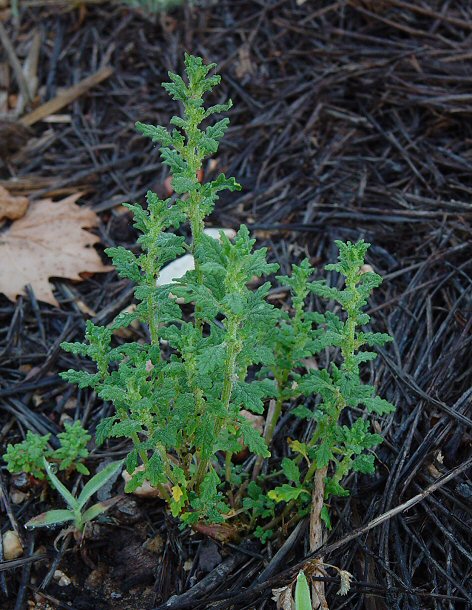Chenopodium pumilio R. Br.
Clammy Goosefoot

Introduced
CC = *
CW = 5
MOC = 19
© DETenaglia
Chenopodium pumilio R. Br.Clammy Goosefoot | |
 |
Introduced CC = * CW = 5 MOC = 19 |
© DETenaglia |
|
Family - Chenopodiaceae Habit - Taprooted annual forb with an unpleasant odor. Stems - Prostrate to loosely ascending, to 40 cm, few- to much-branched near the base, longitudinally ridged, fragrant, viscid, with dense, short, glandular hairs, pale green to whitish, usually lacking reddish areas. Leaves - Alternate, petiolate, mostly pinnately lobed, fragrant. Leaf blades 0.5-3.0 cm long, those of well-developed leaves mostly 1.5-3.0 times as long as wide, lanceolate to ovate, mostly bluntly pointed at the tip, rounded or angled at the base, mostly with few rounded lobes, occasionally nearly entire (uppermost leaves), yellowish green and herbaceous in texture, the margins usually also wavy or with shallow, blunt, narrow teeth, the surfaces lacking mealiness, but with dense, sessile, yellowish resin glands. Venation noticeably branched, usually with 1 main vein. Petioles to 5 mm long, pubescent and glandular.
Inflorescence - Short axillary spikes or small clusters of flowers. Flowers not all maturing at the same time. Each flower on a very short pedicel to 0.2 mm long. Flowers - Perfect, apetalous. Calyx 5-lobed nearly to the base, somewhat spreading and exposing the fruit at maturity, glandular-pubescent, the lobes 0.5-0.7 mm long, elliptic-ovate to oblong-elliptic, usually sharply pointed at the tip, flat or more commonly rounded to somewhat pouched dorsally, moderately to densely pubescent with dense, sessile, yellowish resin glands, sometimes also with sparse to moderate, short, nonglandular hairs. Stamens usually 1. Anthers bilobed, pale yellow to white, 0.3 mm broad. Ovary minute, green, glabrous, 0.2 mm in diameter. Stigmas 3.
Fruits - Fruits 0.5-0.7 mm long, ovoid, the seeds positioned vertically, the wall thin, membranous, and somewhat translucent, smooth to finely and faintly wrinkled, difficult to separate from the seed. Seeds reddish brown to dark brown, 0.5 mm in diameter, shiny, smooth, rounded along the rim. Flowering - August - October. Habitat - Streambanks, pond margins, crop fields, pastures, farmyards, disturbed sites, rocky or sandy soils, roadsides, railroads. Origin - Native to Australia. Lookalikes - No info yet. Other info. - In Missouri this small species is restricted almost entirely to the southern 1/3 of the state. Across the U.S. it is sporadic and mostly uncommon, though it is apparently present in most of California. The plant is an exotic and thrives in disturbed areas. This is one of the easier species of Chenopodium to identify because of its strong fragrance, sticky stems, small size, and pinnately-lobed leaves. Photographs taken at Logan Creek, Reynolds County, MO., 7-13-03. |